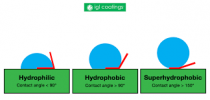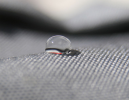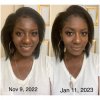Chicoro
9 Year Shea Anniversary: Started Dec 16th, 2016!
Another testament showing luscious ends using wash n go's!
@GettingKinky
@ckisland
Feature of the month Dee Raven wears wash and go's. She had tailbone length hair and her ends look nice:

@GettingKinky
@ckisland
LHCF - Feature of the Month
The Ultimate Hair Care & Beauty Resource for Women of Color
fotm.longhaircareforums.com
Feature of the month Dee Raven wears wash and go's. She had tailbone length hair and her ends look nice:






 so it forms a bead. The thicker or greasier or waxier the surface, the tighter the ball of water rolls up. The thicker the grease on the surface, the BIGGER the contact angle of the water bead, to the the surface.
so it forms a bead. The thicker or greasier or waxier the surface, the tighter the ball of water rolls up. The thicker the grease on the surface, the BIGGER the contact angle of the water bead, to the the surface.

 )
) I had a professional hair analysis done years ago and they told me the same thing.
I had a professional hair analysis done years ago and they told me the same thing.


